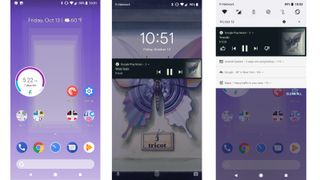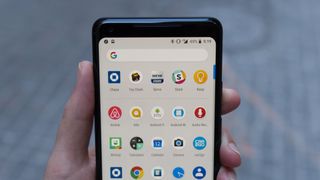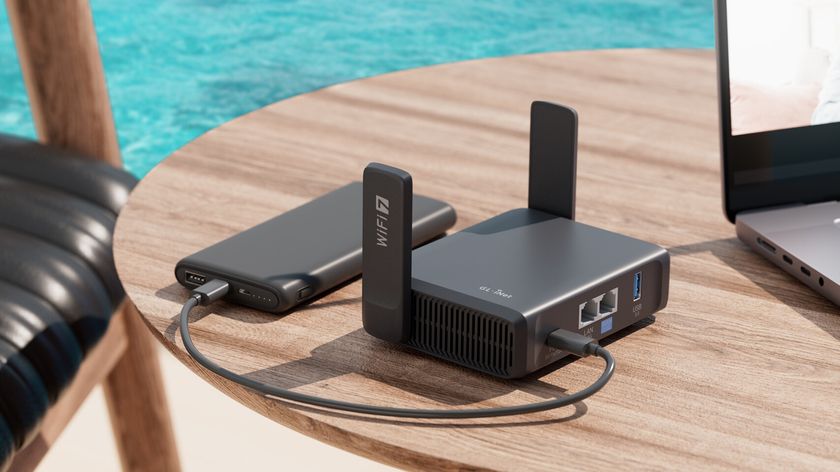Why you can trust TechRadar
Interface and reliability
- Android Oreo, as it was meant to be experienced
- Refreshed Pixel Launcher is all about elegance and intelligence
Using the Google Pixel 2 XL isn’t too different an experience than what you’ll find on a large majority of smartphones. It is Android, after all.
However, there are quite a few unique touches that make this twist on Android Oreo different than the rest.
This is a stock Android device, meaning primarily that there is zero bloatware. The Pixel Launcher has anchored the Google search bar to the bottom of the screen, with pertinent calendar, time and date information embedded near the top.
Like last year’s implementation, these elements aren’t mobile, but if you don’t mind the rigidity of the interface compared to other Android implementations, you’ll warm up to it.

How you download and manage apps is, of course, unchanged, but there are a handful of settings that make the day-to-day usage of the Pixel 2 XL a bit different than any previous Google-made device.
As mentioned earlier, there’s an always-on display, which is a feature that we’ve been wishing for and it aids in giving you more information without having to even touch the phone.
You can quickly jump in by giving the display a few taps or by placing a finger on the ideally-located Pixel Imprint sensor on the Pixel 2 XL’s rear. But if all you need are hard answers from Google Assistant, you can give the phone a squeeze to boot straight in.
From a powered-down state, the new Pixel can boot up in about 10 seconds, which compared to just about every other Android device is ridiculously fast.
Android Oreo is really starting to strut its stuff, beyond just its subtle improvements to the interface and the increased efficiency of apps.
Additionally, given that the Pixel 2 XL is one of the first devices to support Project Treble, (a way for easier updates to land with the phones) Google’s support for this phone might extend past Android P and Android Q, all the way to Android R, possibly.

Music, movies and games
- Dual front speakers make for a surprisingly enjoyable viewing experience
- More media-friendly as internal storage has doubled over last year’s default
- No 3.5mm jack, but dongle included and wireless reliability is actually quite good
When it comes to entertainment, there are plenty of devices that we’d recommend over Google’s previous smartphones. But this year’s Pixel is a different story.
While the lack of a headphone jack might cripple its standing to you, the taller aspect ratio, boosted internal storage and high-speed components make the Pixel 2 XL as good an option for enjoying media as most 2017 flagship smartphones, regardless of operating system.
Starting with music, Google has opted to leave behind the headphone jack, though it has included a USB-C to 3.5mm adapter that remedies the issue.
However, if you’re ready to go wireless, this device features Android Oreo’s high-quality wireless audio codecs and Bluetooth 5.0 to make it a surprisingly good and painless experience.
Pairing with “Made for Google” wireless headphones, in our experience, is lightning fast - a far cry from previous Bluetooth experiences on Android.
aptX HD, one of the supported codes, in addition to Sony’s LDAC, sounds fantastic and better yet, the strength of the connection is rock solid.
Of course, you can just listen to tunes through the dual front speakers, which will yield a better experience than you’ll get with most phones. However, as good as they are, you’ll still be better served with a pair of headphones.
Moving onto visual entertainment, Google has worked to account for its taller display by working in a gesture that spreads content to fill the 18:9 aspect ratio. On both YouTube and Netflix, we found settings to make sure no pixel went without a job.
When it comes to games, it’s pretty much the same story. We’ve found that many recent hits, including Super Mario Run and Fire Emblem Heroes partially support the 18:9 aspect ratio, but the bottom bezel is sliced off. However, Rayman Adventures plays blissfully on the entire display.
But regardless of the title’s support (or lack thereof) for the display size, each and every one plays perfectly thanks to the Pixel 2 XL’s pOLED display running at 2,880 x 1,440 and the guts running inside.
All in all, it would have been nice to have microSD support here, given that so many popular flagships offer the feature, like the LG V30, Samsung Galaxy S8 and a few others.
But the fact that Google doubled the default storage from 32GB to 64GB is a plus, but more so for the Pixel 2, which does so while keeping the same price as last year’s small option. As you know already, the Pixel 2 XL is quite a bit more expensive than last year’s.

Specs and performance
- Snapdragon 835 and 4GB of RAM are a delightful combo for a no-lag experience
- Specs don’t tell the entire story here (in a good way)
At Google’s launch event, it stated that judging a phone based on specs alone doesn’t cut it anymore. While there’s some truth in that because of recent advancements in cloud computing and utilizing some artificial intelligence-like smarts to achieve, say, fantastic photo results, there’s also still value in breaking down what’s inside.
The Pixel 2 XL features the Snapdragon 835 chipset, much like what we’ve seen in the Samsung Galaxy Note 8, OnePlus 5 and many others, as well as a standard 4GB of RAM.
On the whole, it feels as fast as the others in most tasks. Multi-tasking is quick as can be, as is the general performance found in games and downloading media content. But there are some areas where the performance seems to defy the specs.
This device’s impressive 10-second boot times are a good example of Google’s tightly-knit software and hardware working together to achieve more than was previously possible.
Obviously, only time will tell if Google can keep things speedy with future updates, but it has been one of the more apparent facets of the Pixel 2 XL’s solid performance thus far.
We’ll touch more on this later, but the camera is another area that can’t help but stick out as phenomenal, even though its specs wouldn’t seem to offer anything better than we’ve seen before.
Looking at benchmark scores compared to other flagships, the Note 8’s 6GB of RAM and Snapdragon 835 helped to keep it comfortably above the 6,000 multi-core score.
With a slight drop in RAM to 4GB, we’re impressed that the Pixel 2 XL can also hang with it, putting up an average of 6,120. In the end, numbers are numbers, and we’re confident in saying that it can provide a true flagship experience, but it’s worth knowing where this phone lies in the spectrum of power.
Current page: What's it like to use?
Prev Page Introduction, design and display Next Page Camera and battery lifeCameron is a writer at The Verge, focused on reviews, deals coverage, and news. He wrote for magazines and websites such as The Verge, TechRadar, Practical Photoshop, Polygon, Eater and Al Bawaba.














